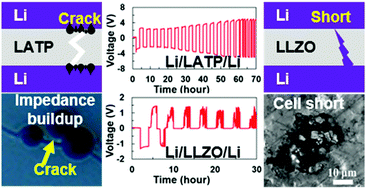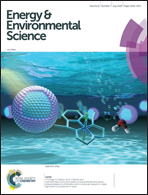The role of the solid electrolyte interphase layer in preventing Li dendrite growth in solid-state batteries†
Abstract
Lithium (Li) metal anodes have regained intensive interest in recent years due to the ever-increasing demand for next-generation high energy battery technologies. Li metal, unfortunately, suffers from poor cycling stability and low efficiency as well as from the formation of dangerous Li dendrites, raising safety concerns. Utilizing solid-state electrolytes (SSEs) to prevent Li dendrite growth provides a promising approach to tackle the challenge. However, recent studies indicate that Li dendrites easily form at high current densities, which calls for full investigation of the fundamental mechanisms of Li dendrite formation within SSEs. Herein, the origin and evolution of Li dendrite growth through SSEs have been studied and compared by using Li6.1Ga0.3La3Zr2O12 (LLZO) and NASICON-type Li2O–Al2O3–P2O5–TiO2–GeO2 (LATP) pellets as the separators. We discover that a solid electrolyte interphase (SEI)-like interfacial layer between Li and SSE plays a critical role in alleviating the growth of dendritic Li, providing new insights into the interface between SSE and Li metal to enable future all solid-state batteries.

- This article is part of the themed collection: 2018 Energy and Environmental Science HOT Articles


 Please wait while we load your content...
Please wait while we load your content...
